Wireless Ad Hoc Network Technology VBee and Its Application Examples
1. R & D of Huaaotong's wireless short-range ad hoc network project
Our company is a high-tech enterprise specializing in the research and development and sales of ODM wireless data communication modules. Since 2006, we have been developing short-range ad hoc wireless modules. The mass production of self-organizing wireless modules is divided into two types. One is a 2.4GHz wireless module based on ZigBee technology, and the other is a 470MHz frequency band wireless module based on VBee ad hoc network technology.
ZigBee is a short-range, low-power, low-cost wireless communication technology launched by the ZigBee Alliance. Huaaotong's main products adopting ZigBee technology are HAC-uBee, HAC-LBee, etc., Huaaotong's ZigBee module has been successfully applied in various projects such as logistics, building energy saving, and data collection.
VBee is a wireless self-organizing network technology with more than two years of research and development and Huaaotong has independent intellectual property rights. The product adopting VBee technology is HAC-uNet. The VBee module of Huaaotong has begun to be used in industrial control and data collection. And other projects. VBee is designed to compensate for the poor penetration of RF modules in the 2.4GHz frequency band. It is designed to be unsatisfactory when it is used in densely blocked environments (such as centralized copy projects and other industrial control projects). VBee modules have chosen lower Public frequency bands open by the state.
2. Introduction to Vbee
VBee uses a MESH structured network. Each VBee network consists of a master node (called AP) and a child node with routing function (called NP) and a terminal sleepable node without routing function (called EP). AP Data transmission to NP or AP to EP is called download, and data transmission between NP and EP to AP is called upload.
VBee network has the following characteristics:
Automatic networking, automatic routing

A VBee network is set up by the AP, and its network is set up without external intervention. It is automatically completed after the network node is powered on.
The nodes in the network can automatically determine their hop count in the network according to their positions and the positions of neighboring nodes. For example, as shown in Figure 1, node 02 is farther than node 01, but because node 02 can directly communicate with the AP reliably Therefore, node 02 and node 01 are the same as one hop. When communicating with AP, node 02 can directly communicate with AP without passing 01.
In addition to automatic networking, data transmission in the network is also automatic routing and intelligent selection of the best transmission path.
The automatic selection of the shortest path is another major feature of VBee. For example, as shown in Figure 1, the upload data of node 09 can reach the AP through the path of node 07-> node 03, or reach the AP through node 08. 3 hops, and the latter path only needs 2 hops. Therefore, the upload data of node 09 will automatically choose to transmit uplink data through node 08.
Large network capacity and wide coverage
A VBee network can have up to 1000 nodes, plus a large number of network hops (the maximum number of hops can reach 8 hops). Therefore, the communication coverage of VBee will greatly exceed the coverage of traditional point-to-point and point-to-multipoint modes.
Network ID design to avoid mutual interference
The network ID contains the physical channel number of the RF module, which can not only ensure that all RF modules in the same VBee network work on the same channel, but also eliminate the problem of mutual interference of RF modules between different VBee networks working in the same area.
Data transmission collision avoidance design and data retransmission design improve the success rate of network data transmission
According to calculations and tests, if collision avoidance and retransmission technology is not used, if the single hop success rate in the network is 90%, then after 8 hops, the data transmission success rate is only 43%, even if the single hop success rate is 99% After 8 jumps, only 92%.
Because VBee uses the collision avoidance and retransmission technology of data transmission, the success rate of data transmission in the network can be greatly improved.
Easy to install on site
Based on some clever designs, all nodes do not need to perform complicated network static or dynamic routing settings according to the site environment when installing on site, nor do they need to set nodes on site.
The replacement of the faulty module and the addition of new network nodes do not require system restart or configuration.
This allows ordinary installation workers to complete on-site node installation and replacement.

4. Some comparisons between VBee module and ZigBee module

Table 2. Comparison of VBee module and ZigBee module
It can be seen from Table 2 that the wireless transmission network is the same. The main difference between the VBee module and the ZigBee module is the difference between the wireless carrier frequency and the wireless transmission rate. ZigBee uses a 2.4G carrier frequency, while VBee is a 400M-500M carrier frequency. It is determined that the wireless penetration of the VBee module is much better than the ZigBee module. Therefore, in a complex environment blocked by buildings, the actual transmission distance of the VBee module is farther than ZigBee, and the transmission reliability is higher, but the VBee module ’s The wireless transmission rate is much lower than the ZigBee module. Therefore, in some solutions that require high-standard real-time control, the ZigBee module is more suitable than the VBee module.
V. Application examples
The following project is an example of an enterprise using our company's HAC-uNet for temperature acquisition and system control, as shown in Figure 2.
In this project, HAC-uNet is used for temperature collection and data transmission. In the project, all HAC-uNets form a VBee network. In the VBee network, the function design of one HAC-uNet is AP, and the function design of the remaining HAC-uNet For NP and EP, some nodes in the project use EP, because in the actual environment, the power supply of individual nodes is difficult and the battery-powered method is used. In order to ensure the sufficient service life of the battery, EP is used.
The AP is directly connected to the host computer of the acquisition system through its RS232 interface. The host computer software reads the temperature collected and uploaded by each node in VBee through the AP, and the control data is downloaded to each node (NP / EP) through the AP. The node (NP / EP) then transmits the control data to the control device through the RS485 interface.
DS18B20 is used for temperature acquisition. HAC-uNet directly controls DS18B20 to acquire and read the temperature data collected by DS18B20.
See Figure 3 and Figure 4 for the actual control flow.



Soundproof Yuchai Diesel Generator
Yuchai Generator,Soundproof Yuchai Diesel Generator,Yuchai Soundproof Electric Water Diesel Generato,Soundproof Diesel Generator Yuchai
Jiangsu Lingyu Generator CO.,LTD , https://www.lygenset.com